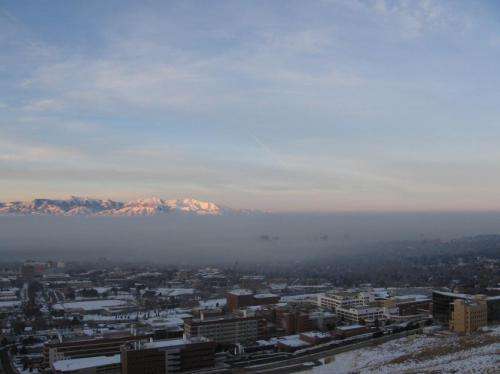Middle-aged men at highest risk of suicide after breathing poor air

A new study from the University of Utah is adding to the small, but growing body of research that links air pollution exposure to suicide.
In research published today in The American Journal of Epidemiology, investigator Amanda Bakian, Ph.D., an assistant professor of psychiatry at the University of Utah, and her colleagues outline chemical and meteorological variables that are risk factors for suicide. Their study, titled "Risk assessment of air pollution and suicide," examines how those factors play out among different genders and age groups. The findings build on other research by Bakian released in April 2014, when she found that fine particulates and nitrogen dioxide in air pollution are linked with an increased risk for suicide.
In the latest study, Bakian and researchers found an increased risk of suicide associated with short-term exposure to nitrogen dioxide and fine particulate matter among Salt Lake City residents who died by suicide between 2000 to 2010. In particular, men and Salt Lake City residents between 36 to 64 years of age experienced the highest risk of suicide following short-term air pollution exposure.
"We are not exactly sure why risk of suicide was higher in these two groups but suspect that it might be because these two groups were either exposed to higher levels of air pollution or that other additional factors make these two groups more susceptible to the effects of air pollution," said Bakian.
Bakian examined the records of more than 1,500 people who died by suicide in Salt Lake County between Jan. 1, 2000, and Dec. 31, 2010, and found that the odds of completing suicide were 20 percent higher for people exposed to increased levels of nitrogen dioxide in the two to three days before their deaths. Similarly, individuals exposed to high concentrations of fine particulate matter (PM2.5) in the two to three days before a suicide experienced 5 percent higher odds of suicide. Research found the risk was highest during the spring and fall —not the winter months when inversions are most common.
Data from the records also revealed that men experienced a 25 percent increase in the odds of suicide following short-term exposure to nitrogen dioxide and a 6 percent increase in the odds of suicide following short-term exposure to fine particulate matter. In addition, the odds of suicide in people between the ages of 36 to 64 increased by 20 percent following short-term exposure to nitrogen dioxide and 7 percent following short-term exposure to fine particulate matter.
"As suicide risk was found to differ by age and gender, this suggests that vulnerability to suicide following air pollution exposure is not uniform across Salt Lake County residents and that some Salt Lake County residents are more vulnerable than others," said Bakian. "Our next step is to determine in more detail exactly what elements—such as genetic and sociodemographic factors —are responsible for increasing one's vulnerability to suicide following air pollution exposure."
She is careful to point out that the research doesn't state that bad air causes suicide. While the study doesn't prove that air pollution causes someone to commit suicide, it suggests that higher levels of pollution might interact with other factors to increase the risk for suicide, she noted.















